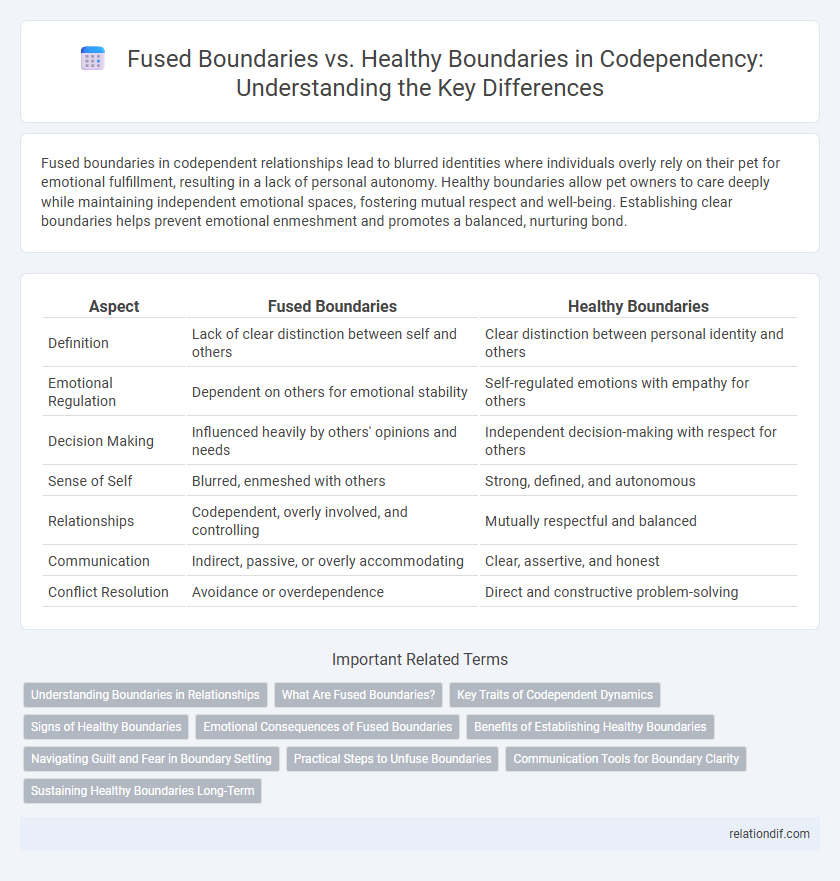Fused boundaries in codependent relationships lead to blurred identities where individuals overly rely on their pet for emotional fulfillment, resulting in a lack of personal autonomy. Healthy boundaries allow pet owners to care deeply while maintaining independent emotional spaces, fostering mutual respect and well-being. Establishing clear boundaries helps prevent emotional enmeshment and promotes a balanced, nurturing bond.
Table of Comparison
| Aspect | Fused Boundaries | Healthy Boundaries |
|---|---|---|
| Definition | Lack of clear distinction between self and others | Clear distinction between personal identity and others |
| Emotional Regulation | Dependent on others for emotional stability | Self-regulated emotions with empathy for others |
| Decision Making | Influenced heavily by others' opinions and needs | Independent decision-making with respect for others |
| Sense of Self | Blurred, enmeshed with others | Strong, defined, and autonomous |
| Relationships | Codependent, overly involved, and controlling | Mutually respectful and balanced |
| Communication | Indirect, passive, or overly accommodating | Clear, assertive, and honest |
| Conflict Resolution | Avoidance or overdependence | Direct and constructive problem-solving |
Understanding Boundaries in Relationships
Fused boundaries occur when individuals in a relationship lose their sense of self, resulting in an unhealthy reliance on others for identity and emotional regulation. Healthy boundaries allow each person to maintain autonomy, fostering mutual respect and clear communication without enmeshment. Understanding these distinctions is crucial for building balanced relationships where personal needs and emotional well-being are honored.
What Are Fused Boundaries?
Fused boundaries occur when individuals lose their sense of self and become overly enmeshed with others, leading to blurred personal limits and an inability to distinguish their own emotions from those of those around them. This lack of separation often results in codependent behaviors, where one's identity and decisions are excessively influenced by another person's needs and feelings. Healthy boundaries, by contrast, maintain clear emotional and psychological limits, supporting autonomy and mutual respect in relationships.
Key Traits of Codependent Dynamics
Fused boundaries in codependency often result in blurred personal identities and an excessive reliance on others for self-worth, leading to difficulty making independent decisions and emotional enmeshment. Healthy boundaries promote autonomy and self-respect, allowing individuals to maintain their own emotional needs while supporting others without losing their sense of self. Key traits of codependent dynamics include people-pleasing behaviors, a fear of abandonment, and difficulty expressing true feelings due to a lack of clear, assertive boundaries.
Signs of Healthy Boundaries
Signs of healthy boundaries include clear communication of personal limits, respect for individual autonomy, and the ability to say no without guilt. People with healthy boundaries maintain a balance between their own needs and the needs of others, fostering mutual trust and emotional safety. These boundaries support self-care and prevent emotional enmeshment often seen in codependent relationships.
Emotional Consequences of Fused Boundaries
Fused boundaries in codependency often lead to emotional enmeshment, where individuals lose their sense of self and experience heightened anxiety, guilt, and resentment. These blurred boundaries prevent healthy emotional regulation, causing mood swings and dependency on others for validation. Establishing clear, healthy boundaries promotes emotional independence and stability, reducing emotional exhaustion and improving overall mental well-being.
Benefits of Establishing Healthy Boundaries
Establishing healthy boundaries enhances emotional well-being by promoting self-respect and reducing anxiety associated with fused boundaries. Clear boundaries enable individuals to maintain autonomy while fostering mutually respectful relationships, preventing codependent dynamics. This foundation supports personal growth, improved communication, and a balanced sense of self within connections.
Navigating Guilt and Fear in Boundary Setting
Fused boundaries blur individual identities, intensifying guilt and fear when attempting to establish limits in codependent relationships. Healthy boundaries foster self-awareness and assertiveness, reducing emotional manipulation and enabling effective navigation of discomfort during boundary setting. Recognizing the difference empowers individuals to manage guilt and fear constructively, promoting emotional independence and balanced connections.
Practical Steps to Unfuse Boundaries
To unfuse boundaries in codependent relationships, start by clearly identifying and asserting your personal needs and limits without guilt. Practice saying no and setting consequences when boundaries are crossed, reinforcing your autonomy. Engage in self-reflection or therapy to recognize enmeshment patterns and develop skills to maintain emotional independence while respecting others.
Communication Tools for Boundary Clarity
Clear communication tools such as assertive language and active listening are essential for establishing healthy boundaries, ensuring each person's needs and limits are respected without confusion. In contrast, fused boundaries often involve blurred communication where individuals struggle to express personal limits, leading to misunderstandings and emotional enmeshment. Techniques like "I" statements and regular boundary check-ins promote clarity, preventing codependent patterns and fostering mutual respect.
Sustaining Healthy Boundaries Long-Term
Sustaining healthy boundaries long-term involves recognizing and maintaining clear distinctions between personal needs and others' expectations, which prevents the enmeshment characteristic of fused boundaries in codependency. Consistent self-awareness and assertive communication reinforce these boundaries, enabling emotional autonomy and mutual respect in relationships. Utilizing therapeutic techniques such as cognitive-behavioral strategies and mindfulness helps individuals solidify their boundaries and reduce dependency patterns over time.
Fused Boundaries vs Healthy Boundaries Infographic

 relationdif.com
relationdif.com